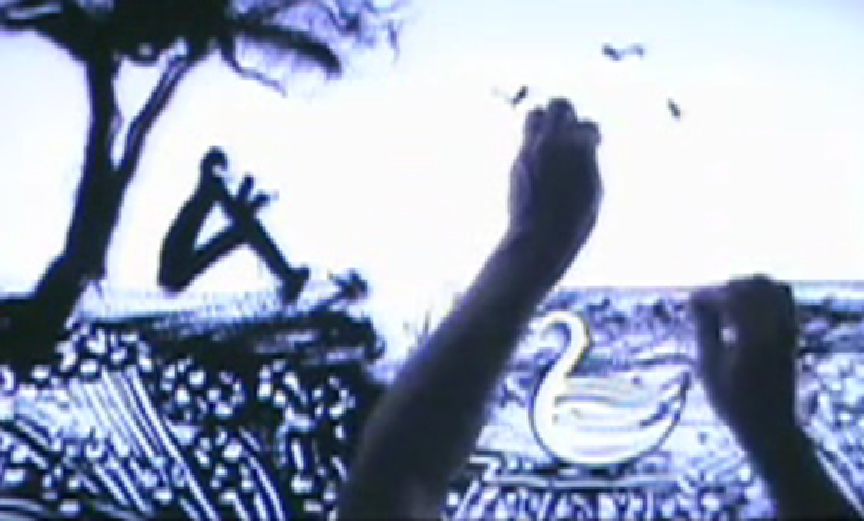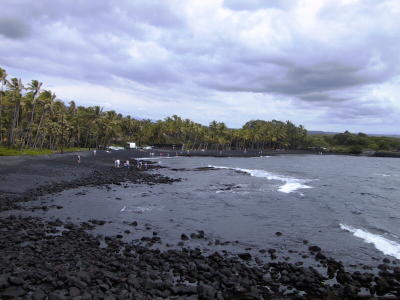Unless you’re lucky enough to have visited some of the unique shorelines below you’ll probably be used to seeing golden beaches on your travels. A lot of people believe golden sands to be the only option when it comes to beaches. To prove otherwise, and to show off a few of the world’s most uniquely colored stretches of sand, we present the following selection….
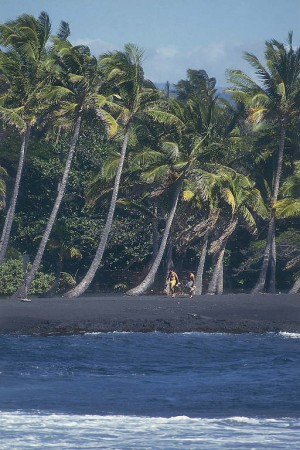 Punalu’u Beach is the most visited of the few black sand beaches on Hawaii’s Big Island and the stunningly black sand is actually volcanic rock, deposited as lava and subsequently cooled when met by the ocean. Apparently to take any of the sand home would result in you being cursed by a volcano goddess by the name of Pele. Punalu’u Black Sand Beach is a gem of a find on the Big Island of Hawaii. Located halfway between Volcano and Na’alehu on the southern portion of the Big Island of Hawaii. Punalu’u Black Sand Beach is right next to the Sea Mountain Golf course, and the old now non-functional Sea Mountain Restaurant.
Punalu’u Beach is the most visited of the few black sand beaches on Hawaii’s Big Island and the stunningly black sand is actually volcanic rock, deposited as lava and subsequently cooled when met by the ocean. Apparently to take any of the sand home would result in you being cursed by a volcano goddess by the name of Pele. Punalu’u Black Sand Beach is a gem of a find on the Big Island of Hawaii. Located halfway between Volcano and Na’alehu on the southern portion of the Big Island of Hawaii. Punalu’u Black Sand Beach is right next to the Sea Mountain Golf course, and the old now non-functional Sea Mountain Restaurant.
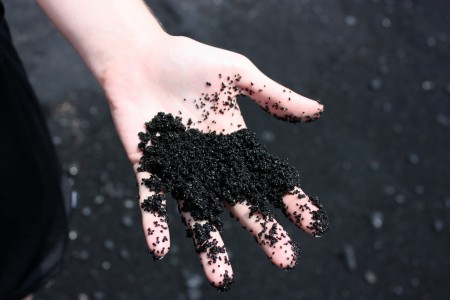
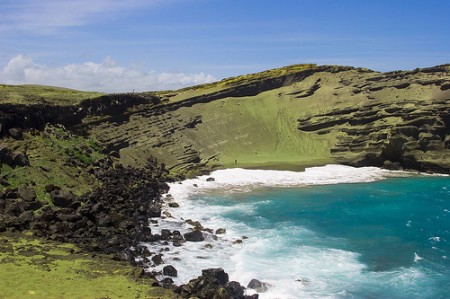 One of only 2 green sand beaches in the world, the truly magnificent sight of Papakolea Beach can be experienced by traveling to Hawaii’s Ka’u district. Again, the unique color of its sand can be attributed to volcanic activity – specifically, the green hue belongs to the abundance of olivine crystals, which have been produced as a result of a nearby cinder cone erupting and eroding. Known as Green Sand Beach or even Pu’u o Mahana, Papakolea Beach, is well deserving of its name.
One of only 2 green sand beaches in the world, the truly magnificent sight of Papakolea Beach can be experienced by traveling to Hawaii’s Ka’u district. Again, the unique color of its sand can be attributed to volcanic activity – specifically, the green hue belongs to the abundance of olivine crystals, which have been produced as a result of a nearby cinder cone erupting and eroding. Known as Green Sand Beach or even Pu’u o Mahana, Papakolea Beach, is well deserving of its name.
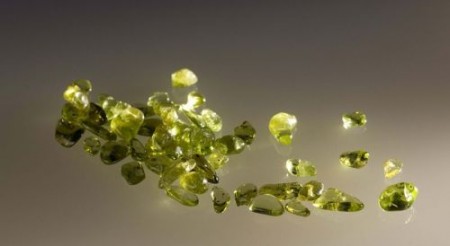 The olive-like color of the sand comes from the presence of a greenish, semi-precious stone named, appropriately enough, olivine. The erosive force of the ocean washing into the base of Pu’u o Mahana cinder cone has extracted olivines out of the cinder. These are deposited on the sand, giving the sand a green tint. This secluded, and we do mean secluded, sand beach is located near Ka Lae (South Point) in the Ka’u district of Hawaii. The hike is a rugged 2-mile dusty labyrinth of ruts that eventually lead to the beach. Getting down to the beach is an entirely different issue. Shaped like a giant bowl, you have to climb down the side of the „bowl” to reach the beach. Braving the rugged road down, you might be tempted to ask yourself if it’s really worth the trip. It’s not easy to get to, but where else can you see a Green Sand beach?
The olive-like color of the sand comes from the presence of a greenish, semi-precious stone named, appropriately enough, olivine. The erosive force of the ocean washing into the base of Pu’u o Mahana cinder cone has extracted olivines out of the cinder. These are deposited on the sand, giving the sand a green tint. This secluded, and we do mean secluded, sand beach is located near Ka Lae (South Point) in the Ka’u district of Hawaii. The hike is a rugged 2-mile dusty labyrinth of ruts that eventually lead to the beach. Getting down to the beach is an entirely different issue. Shaped like a giant bowl, you have to climb down the side of the „bowl” to reach the beach. Braving the rugged road down, you might be tempted to ask yourself if it’s really worth the trip. It’s not easy to get to, but where else can you see a Green Sand beach?
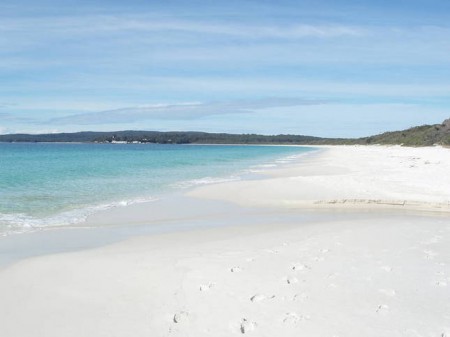 You may need to wear your shades when visiting Hyams Beach in New South Wales, Australia, but not just due to the sun. It’s not surprising after looking at photos but this sublime stretch of beach is home to the whitest sand in the world, an honor awarded by the Guinness Book of Records. Welcome to the number one tourist destination in the state of New South Wales. Hyams Beach at Jervis Bay is just two and a half hours from Sydney and around three hours from Canberra. There are so many natural attractions around here you won’t run out of things to do. We promise.
You may need to wear your shades when visiting Hyams Beach in New South Wales, Australia, but not just due to the sun. It’s not surprising after looking at photos but this sublime stretch of beach is home to the whitest sand in the world, an honor awarded by the Guinness Book of Records. Welcome to the number one tourist destination in the state of New South Wales. Hyams Beach at Jervis Bay is just two and a half hours from Sydney and around three hours from Canberra. There are so many natural attractions around here you won’t run out of things to do. We promise.
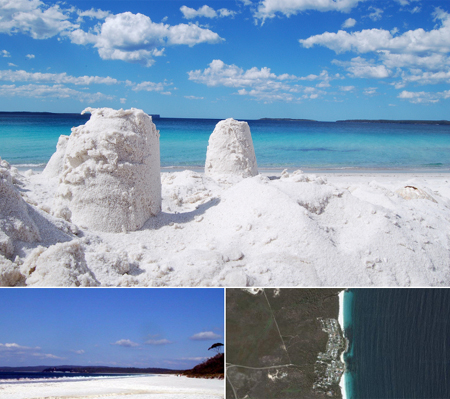 Renowned worldwide for its perfect white sand, Hyams Beach is the most famous and popular of the myriad bays and beaches inside Jervis Bay. Facing east and looking directly at Point Perpendicular, Hyams rarely receives any swell other than a gentle shore break in a nor’easter, making it a safe family patch. But, like all beaches in the bay, it is unpatrolled. At the north end of the wide 2km shoreline is a rock platform with its own sandy beach – and a top snorkeling spot. South of Booderee National Park, in Wreck Bay, is an Aboriginal settlement and home to the famed „Aussie Pipe” – a hollow left and one of the best surf breaks on the east coast.
Renowned worldwide for its perfect white sand, Hyams Beach is the most famous and popular of the myriad bays and beaches inside Jervis Bay. Facing east and looking directly at Point Perpendicular, Hyams rarely receives any swell other than a gentle shore break in a nor’easter, making it a safe family patch. But, like all beaches in the bay, it is unpatrolled. At the north end of the wide 2km shoreline is a rock platform with its own sandy beach – and a top snorkeling spot. South of Booderee National Park, in Wreck Bay, is an Aboriginal settlement and home to the famed „Aussie Pipe” – a hollow left and one of the best surf breaks on the east coast.
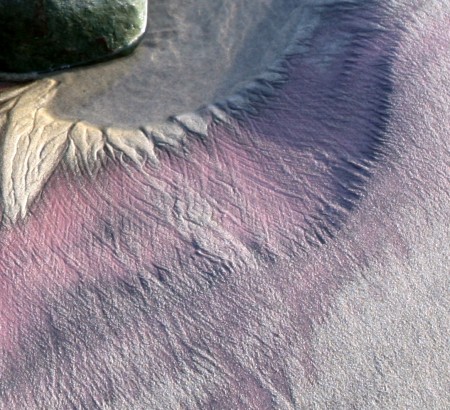 The hills surrounding Pfeiffer Beach in Big Sur, California, are rich in Manganese Garnet. A result of this being washed down onto the beach is the color scheme you can see above – the entire stretch of sand has become a shifting, pink and purple canvas. This is an incredibly scenic beach, but you need to be willing to take the trouble to get to it. It’s almost a secret, probably deliberately. No signs point to it.
The hills surrounding Pfeiffer Beach in Big Sur, California, are rich in Manganese Garnet. A result of this being washed down onto the beach is the color scheme you can see above – the entire stretch of sand has become a shifting, pink and purple canvas. This is an incredibly scenic beach, but you need to be willing to take the trouble to get to it. It’s almost a secret, probably deliberately. No signs point to it.
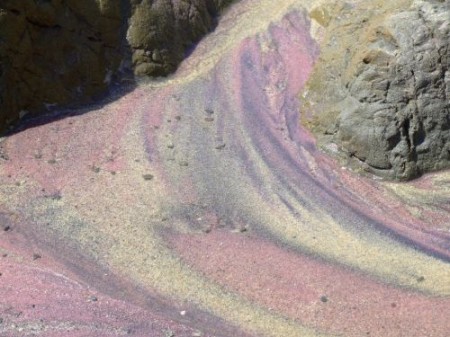 The poorly marked road to it, Sycamore Canyon Road, is about a mile south of the entrance to Pfeiffer Big Sur State Park. The paved, but narrow one-lane road leads down to the beach. There are numerous turnouts to let on-coming traffic pass. There’s a paved parking lot at the end of the road. The path to the beach passes by a warm creek-fed lagoon. Steep rocky cliffs surround the beach. Waves crash on the offshore rocks. The surf hits the curving the beach to the left. The beach in the center (see the picture above) is protected by a rock ridge, which is pierced by sea tunnels. To the left of that, the wind has blown the sand far up the cliff sides, forming slopes that kids can climb up and roll down on (which is where the above picture was taken from). The beach curves to the right, with tide pools and a sandy beach favored by those who can’t seem to afford a swimsuit.
The poorly marked road to it, Sycamore Canyon Road, is about a mile south of the entrance to Pfeiffer Big Sur State Park. The paved, but narrow one-lane road leads down to the beach. There are numerous turnouts to let on-coming traffic pass. There’s a paved parking lot at the end of the road. The path to the beach passes by a warm creek-fed lagoon. Steep rocky cliffs surround the beach. Waves crash on the offshore rocks. The surf hits the curving the beach to the left. The beach in the center (see the picture above) is protected by a rock ridge, which is pierced by sea tunnels. To the left of that, the wind has blown the sand far up the cliff sides, forming slopes that kids can climb up and roll down on (which is where the above picture was taken from). The beach curves to the right, with tide pools and a sandy beach favored by those who can’t seem to afford a swimsuit.
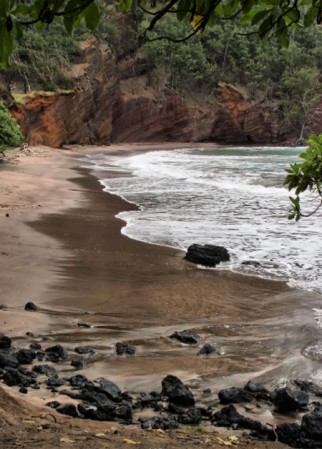 You won’t find many beaches elsewhere in the world with sand as red as this one. Kaihalulu, or Red Sand Beach, is situated on the island of Maui and can thank the neighboring cinder cone hill for its intensely deep red appearance. Located on the far side of Ka’uiki Hill south of Hana Bay is Kaihalulu, better known as Red Sand Beach. The sand gets its red-black color from the crumbling cinder cone hill that surrounds the bay. Swimming is poor except when the ocean is very calm. The path to the beach is slippery due to the crumbling cinder and pine needles from the ironwood trees.
You won’t find many beaches elsewhere in the world with sand as red as this one. Kaihalulu, or Red Sand Beach, is situated on the island of Maui and can thank the neighboring cinder cone hill for its intensely deep red appearance. Located on the far side of Ka’uiki Hill south of Hana Bay is Kaihalulu, better known as Red Sand Beach. The sand gets its red-black color from the crumbling cinder cone hill that surrounds the bay. Swimming is poor except when the ocean is very calm. The path to the beach is slippery due to the crumbling cinder and pine needles from the ironwood trees.
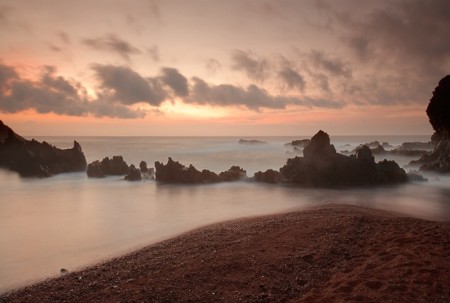 But the view of the red sand against the blue sea bracketed by the green ironwood trees and a rocky lava sea wall is unmatched! This beach is very isolated and nude sunbathers sometimes visit the area.
But the view of the red sand against the blue sea bracketed by the green ironwood trees and a rocky lava sea wall is unmatched! This beach is very isolated and nude sunbathers sometimes visit the area.
Do not swim beyond the lava sea wall due to strong currents. The path to the beach is very slippery, use extreme caution. Always monitor ocean conditions closely. Strong currents and heavy surf may be possible. Obey all signs, warming and postings. The trail to the beach begins across from the Sea Ranch Cottages. It can be tricky in places and is fairly steep. At the bottom of the trail you’ll find an interesting sign that both informs you of “No trespassing” and then “use at your own risk.”





